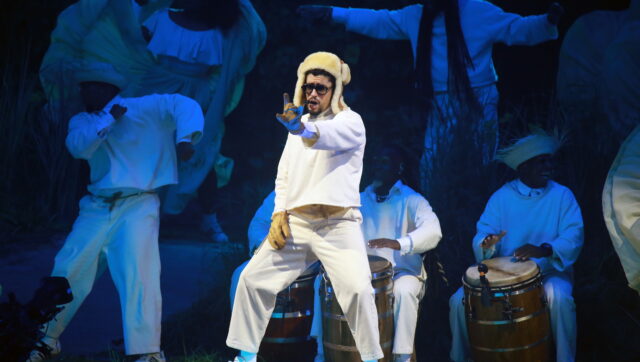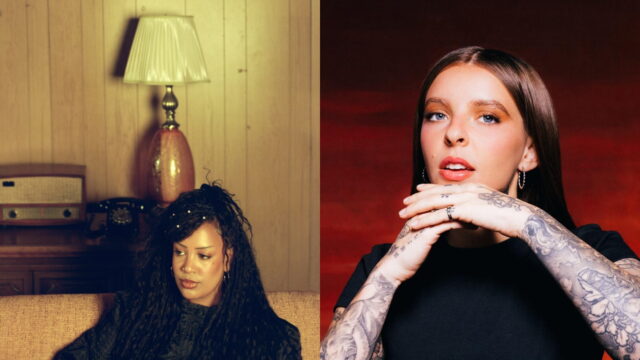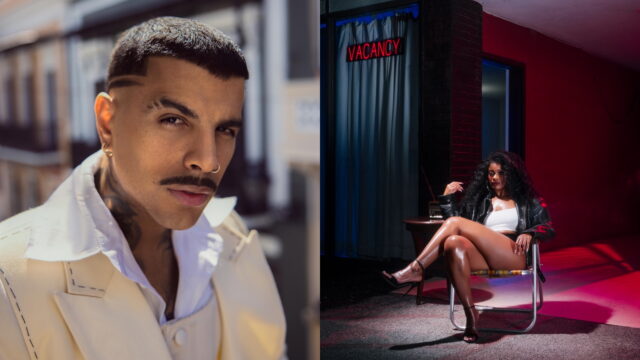Love & Theft in Latin Music
Inside the hugely diverse world of Latin music, artists and communities trade sounds and traditions, often to mega-selling success. But at what point does creative cross-pollination become exploitation and appropriation?
by Jenzia Burgos
Credit: Sony Music Latin.
Latin music, much like its community, has never fit neatly into static definitions of one place or people. We have always reached beyond borders — both real and imagined — blurring the boundaries of genre, geography, language and race in ways that echo the complex exchanges of our ancestors. Artists repeat this legacy. For centuries, they have interpolated and participated in a dizzying array of musical traditions with roots in African, European and indigenous cultures, each with their own unique lineage and expression of what it even means to be Latinx.
In recent years, Latinx artists have set their sights beyond the innate mixtures of their home countries, following inspiration wherever it leads them — even if it’s to a different genre than they’re known for. The result? A kaleidoscope of Caribbean and Latin American influences, each distinct yet reflective of the today’s landscape of popular genres, from bachata and dembow to reggaeton and regional Mexican.
This can look like Puerto Rican rappers Ozuna and Anuel AA recording 2021’s “Municiones,” which combines elements of classic Mexican corridos with contemporary Latin-trap stylings in the burgeoning genre known as corrido tumbados. Rapping atop a bassy polka beat, the duo dips into the genre’s deeply embedded themes of narco and cartel culture in ways that echo their usual lyrics about life on the other side of the law. For bachata legend Romeo Santos, who was born in New York to Dominican and Puerto Rican parents, it means tapping into a different side of regional Mexican music with wunderkind Christian Nodal on the sumptuous mariachi “Me Extraño.” The track, inspired by Santos’ love of the late, great Vicente Fernández, has emerged as one of the most popular songs from his 2022 album Formula, Vol. 3, suggesting a shared appreciation for retrospective and rural music between both communities.
Others from beyond the Dominican Republic have also increasingly found their way into bachata. Spanish singer Rosalía joined Santos on “El Pañuelo,” but only months after first releasing her own take on bachata with The Weeknd in late 2021. Her excursion into the form was preceded by Spanish rapper C. Tangana’s collaboration with Argentinian singer Nathy Peluso, when the pair released “Ateo” in October 2021. A slinky, sensual bachata, the song — whose title means “atheist” in English — sets its music video against the backdrop of a Spanish cathedral. Immediately the subject of religious controversy, “Ateo” and its video also bring into question a history of stigmatization for bachata and its performers. (Notably, this is a history rooted in the hypersexualization of the genre’s predominately Black and countryside originators in the D.R.)
While these forays into other genres are steadily on the rise, there’s nothing new, or particularly rare, about musical mosaics between artists. Popular music in the United States (and beyond) has experienced a long-documented history of racial, cultural and sonic blending, as have many of the reigning genres of Latin America. Take reggaeton, for example. Despite its widely perceived basis in Puerto Rico, the genre is the lovechild of a decades-long interplay between MCs and DJs on the island, Panamanian reggae en español, Jamaican dancehall and U.S. hip-hop. Similarly, multinational salsa bands in 1960s New York City melded a foundation of Cuban son and Afro-Cuban jazz with danzón and mambo, Puerto Rican bomba and plena and other idioms. Even cumbia, reinvented and adapted by Mexican artists throughout the 20th century, remains commercially detached from its traditional folk origins in Colombia. That artists continue to borrow from and collaborate within each other’s genres today only affirms a natural, if not necessary, pattern of musical exchange and evolution.
When done constructively, artists working within each other’s genres practice a fair give and take, while at the same time tapping into parallel realities between their communities. “La Romana,” Bad Bunny’s 2018 linkup with Dominican dembow artist El Alfa, illustrated this especially well. Still on his way to becoming the world’s most-streamed artist at the time, El Conejo Malo could count on the cross-island support of Dominican listeners, whereas Puerto Rican youth, with their existing love of homespun styles, readily appreciated a genre like dembow. After all, with its hurtling beats and repetitive hooks, dembow is perfect party music for both teteos in the D.R. and the marquesinas of Bad Bunny’s Puerto Rico. On an even deeper level, Black identity is also at the core of the distinct slang and aesthetics of dembowseros like El Alfa. For Afro-boricuas in particular, Bad Bunny’s co-sign worked to support connections between both cultures.
There are times, of course, when musical exchanges aren’t as mutually supportive. Four years after “La Romana,” Bad Bunny’s Un Verano Sin Ti — the uncontested album of the summer, and arguably, the year — garnered criticism for failing to publicly feature any Dominican artists, despite being heavily steeped in the country’s slang, musical movements and culture. Meanwhile, during the same summer, Spanish singer Rosalía was set to release her single “Despechá” with Dominican merengue legend Omega, only for his verse to be curiously cut from the final track. (According to Omega, he was informed by Rosalía’s team just two days before the song’s release that he would no longer be featured.)
These instances and others bring up vital questions about national and racial exclusion within the industry. “My first thought is always whether the industry has made space for the creators of a genre. Yes, music is for everybody — but who gets that visibility?” says dembow historian and music journalist Jennifer Mota. “Normally, when it’s Black or indigenous people creating this music, they’re not getting that visibility. And it’s because the music industry in Latin America is so obsessed with whiteness, and the proximity to whiteness, that it doesn’t create space for them.”
Recently, this has been the case most noticeably with genres like bachata and dembow, both of which have roots in Black working-class communities but are increasingly being performed by white Latinx artists. Dr. Angelina Tallaj, an assistant professor of music at Fordham University who specializes in Dominican movements, sees a familiar pattern at play. “Dominican underground and working-class culture, which is really Black, is being appropriated,” she says. “It happened before with reggaeton and so many other genres. There is a continuity of the same narrative of ‘we’re all the same,’ but then all the faces you see are white.”
The Latin music industry, itself a product of Western interest and marketing, has long banked on the assumption that “we’re all Latinx, so we’re all equal” to avoid confronting (and changing) the structures that uphold racial privilege, in which white Latinx and Hispanic artists are afforded advantages because of their skin color. Mestizos, or mixed-race Latinx artists, occupy a gray area where their status is determined by their proximity to whiteness, their level of education, their access to wealth, their citizenship status and so on. But as Dr. Tallaj and Mota point out, for Latinx artists who are unambiguously Black or indigenous (and, oftentimes, from low-income backgrounds), true equality remains to be seen — especially when an artist from outside of their community is the one reaping the benefits of a genre sourced from within.
Others could argue, however, that exposure for the genre is a step in the right direction: By having a commercially established artist become the face of a musical movement, this artist creates a pathway for lesser-known acts to join the field once its popularity has been solidified among a wider (and typically whiter) audience. Yet this rarely leads to an equitable solution. “The argument is always that it’s going to create more visibility and open more doors,” Mota observes. “But is it really? The only thing it’s showing is that now there’s an opportunity for more people that are not from the culture to make this music.”
So what can be done? Collaborations that represent the true originators and compositions of a genre are a good place to start. Dr. Tallaj points to the rise of the Dominican dembow artist Tokischa as a positive example. “She’s definitely being lifted up by all these people that are collaborating with her, like Rosalía and Madonna. She’s gaining visibility, but the product is still Tokischa’s sound,” Dr. Tallaj explains. “It’s not being manufactured,” she adds, noting her style has remained irreverently queer and Black even as it travels beyond the D.R.
Yet artists shouldn’t think their work is done after the occasional one-off, especially if it’s with another established figure. “I’m skeptical about people collaborating, because you just don’t do one dembow track with one artist and then think you can make all these other dembow tracks,” Mota says. “It has to be consistent.” For many artists, this means acknowledging their privilege and making a sustained effort to no longer “center” themselves, she says, in genres to which they are visitors and not originators.
Beyond artists, Latin music industry professionals can also make deeper commitments to support Black and indigenous acts, especially as their genres continue to grow. It is true, commercially speaking, that executives and other personnel must toe a tricky line: Their decisions need to appeal to the sensibilities of mainstream English-speaking audiences, while also managing to engage the distinct yet intersecting groups of Latin American nationals, Spanish speakers and the diaspora — each with its own specific biases surrounding race and culture. But as tastemakers, these individuals have a responsibility to promote a palate of inclusivity rather than uphold the same hierarchies that have disenfranchised their people.
As listeners and lovers of this music, our job then is to remain conscious of the extent to which musical exchange can support unequal power dynamics. At the same time, we must acknowledge and celebrate the ways in which today’s Latinx artists and their communities are beautifully shaped by la mezcla. Only then can we experience their music — its missteps and triumphs — in the truest and highest fidelity.



